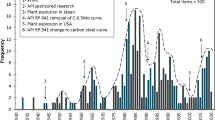The electrochemical corrosion behavior of the low-carbon steel of an elbow of gas pipeline after long term operation with extensive hydrogen-induced delamination was investigated in 0.3% (wt.) NaCl and 8.55 mM NaHCO3 aqueous solutions. The degradation of the corrosion resistance of steel from the pipe elbow in both investigated corrosive environments was revealed. The pipe steel of the elbow (both from the compressed and tensioned sections) was characterized by lower corrosion resistance than the metal of the straight section of the pipe. It was shown that the degradation of corrosion resistance of the pipe-elbow steel correlated with the degradation of its mechanical properties. It was established that the characteristics of corrosion resistance of the degraded material (corrosion current density and polarization resistance) could be informative about changes in its state caused by long-term operation and could be used for the diagnostics of the degradation of mechanical properties of hydrogen-affected steels.

Similar content being viewed by others
References
M. S. Joo, D.-W. Suh, J. H. Bae, and H. K. D. H. Bhadeshia, “Role of delamination and crystallography on anisotropy of Charpy toughness in API-X80 steel,” Mater. Sci. Eng. A, 546, 314–322 (2012).
M. A. Mohtadi-Bonab, J. A. Szpunar, and S. S. Razavi-Tousi, “A comparative study of hydrogen-induced cracking behavior in API 5L X60 and X70 pipeline steels,” Eng. Failure Anal., 33, 163–175 (2013).
R. A. Carneiro, R. C. Ratnapuli, and V. F. C. Lins, “The influence of chemical composition and microstructure of API linepipe steels on hydrogen-induced cracking and sulfide stress-corrosion cracking,” Mater. Sci. Eng. A, 357, 104–110 (2003).
O. T. Tsyrulnyk, Z. V. Slobodyan, O. I. Zvirko, M. I. Hredil, H. N. Nykyforchyn, and D. Gabetta, “Influence of operation of Kh52 steel on corrosion processes in a model solution of gas condensate,” Mater. Sci., 44, No. 5, 619–629 (2008).
C. Zapffe and C. Sims, “Hydrogen embrittlement, internal stress, and defects in steel,” TMS-AIME, 145, 225–232 (1941).
G. Herbsleb, R. K. Poepperling, and W. Schwenk, “Occurrence and prevention of hydrogen-induced stepwise cracking and stress corrosion cracking of low-alloy pipeline steels,” Corrosion, 36, No. 5, 247–256 (1981).
V. N. Polyakov, “Catastrophes of large diameter pipelines: the role of hydrogen fields,” in: Hydrogen Effects in Materials, Moran, Wyoming, USA (1996), pp. 991–1000.
O. T. Tsyrul’nyk, H. M. Nykyforchyn, D. Yu. Petryna, M. I. Hredil, and I. M. Dzioba, “Hydrogen degradation of steels in gas mains after long periods of operation,” Mater. Sci., 43, No. 5, 708–717 (2007).
H. M. Nykyforchyn and O. T. Tsyrul’nyk, “Specific features of the in-service bulk degradation of structural steels under the action of corrosive media,” Strength Mater., 41, No. 6, 651–663 (2009).
R. Mostert and W. Sharp, “Low temperature hydrogen damage assessment in the gas and refining industries,” in: Proc. of the Middle East Nondestruct. Test. Conf. & Exhib, Manama, Bahrain (2005).
L. Ye. Kharchenko, O. Ye. Kunta, O. I. Zvirko, R. S. Savula, and Z. A. Duryahina, “Diagnostics of hydrogen macrodelamination in the wall of a bent pipe in the system of gas mains,” Mater. Sci., 51, No. 4, 530–537 (2016).
H. M. Nykyforchyn and O. T. Tsyrul’nyk, “In-service degradation diagnostics of low-alloyed steels and aluminum alloys properties by electrochemical methods,” Ultrasound, 64, No. 1, 46–49 (2009).
H. Nykyforchyn, O. Tsyrulnyk, M. Hredil, and O. Zvirko, “Correlation between degradation of corrosion and mechanical properties of long-term operated oil and gas pipeline steels,” in: Zeszyty Naukowe, Mechanika. Politechnika Opolska, Z. 99 (2011), S. 41–43.
E. V. Kharchenko, L. K. Polishchuk, and O. I. Zvirko, “Estimation of the in-service degradation of steel shapes for the boom of a clamp-forming machine,” Mater. Sci., 49, No. 4, 501–507 (2014).
Acknowledgement
The research was partially financially supported by the Ministry of Education and Science of Ukraine under the Project M/227-2015.
Author information
Authors and Affiliations
Corresponding author
Additional information
Published in Fizyko-Khimichna Mekhanika Materialiv, Vol. 52, No. 6, pp. 104–108, November–December, 2016.
Rights and permissions
About this article
Cite this article
Zvirko, O.I., Mytsyk, A.B., Tsyrulnyk, O.T. et al. Corrosion Degradation of Steel of an Elbow of Gas Pipeline with Large-Scale Delamination after Long-Term Operation. Mater Sci 52, 861–865 (2017). https://doi.org/10.1007/s11003-017-0032-8
Received:
Published:
Issue Date:
DOI: https://doi.org/10.1007/s11003-017-0032-8




